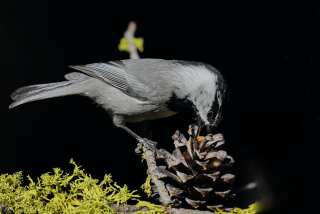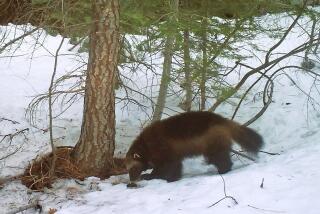GREENSPACE
- Share via
You’ve probably never seen one, let alone heard of it, but the tiny American pika might soon become the little mammal that roared.
A small relative of the rabbit, the pika dwells among boulder fields of the Sierra and other high-altitude ranges, and as such is wonderfully adapted to life in cold climates. But with global warming causing mountain temperatures to rise, it is a creature running out of room.
The Center for Biological Diversity and the U.S. Fish and Wildlife Service reached a settlement last week that might bring the pikas’ predicament into the spotlight.
Under the agreement, federal authorities must determine by May whether the pika warrants listing as a federally protected endangered species. If the answer is yes, the little creature -- which emits a squeaky call familiar to hikers in some areas -- probably would be formally placed on the list by early 2010.
That would make it a poster child of sorts as the first mammal in the lower 48 states needing federal protection due to global warming.
A third of the pika population in the mountains of Nevada and Oregon has died out in the last century as temperatures warmed. Those that remain in Western states are found 900 feet up from their normal habitat. Experts have predicted that U.S. temperatures will rise twice as fast this century as they did over the last 100 years, leading some to fear the creature could disappear from huge swaths of the American West.
Warm temperatures can cause the critters to die of overheating. Climate change also threatens to reduce the insulating winter snowpack they depend on and probably will shorten the foraging season for an animal that weighs just a third of a pound but collects more than 60 pounds of vegetation to survive the winter.
“Global warming has hit home in the lower 48 states, and this is our chance to act,” said Gregory C. Loarie, an attorney with the environmental law firm Earthjustice. “If we lose the pika to climate change, we can expect other species to follow.”
It remains unclear what benefits endangered species protections could bring to the pika. Like polar bears threatened by melting sea ice linked to global warming, the avenues of change needed to protect the pika sometimes seem bigger than the globe we share with them.
-- Eric Bailey
--
Fish farms studied
The salmon you ate last night probably didn’t come from an icy stream in the Pacific Northwest, but from a cage submerged in the ocean where the fish spent months fattening up on feed before being harvested.
Fish farming, an inexpensive way to supply salmon, cod, trout and other popular fish to consumers, produces an estimated 30% of the fish eaten by humans.
But it’s not without harmful side effects. Urine, fecal matter and uneaten feed from fish farms could be carried greater distances than previously thought, according to Stanford researchers.
Uneaten commercial feed gets carried off by currents. And the fish -- often penned up by the thousands -- create waste streams in the ocean.
It had previously been assumed that the waste matter would be diluted by the sea if farming pens were kept far enough from the shore, said Jeffrey Koseff, co-director of Stanford’s Woods Institute for the Environment. But new software that simulates fluid dynamics indicates that waste from fish farming will travel farther and in higher concentrations than scientists thought, Koseff said.
Currents that flush out the pens could ultimately carry the waste to public beaches or mangrove ecosystems. And if not enough currents flow through the pen, fecal matter and uneaten food could pile up beneath the fish and create a “dead zone” on the ocean floor -- an area where there’s not enough oxygen in the water for plants and animals to survive.
-- Catherine Ho
--
Aid in Farm Bill
Conservation initiatives in the 2008 Farm Bill could help animals safely migrate across Western states, according to a report by the Environmental Defense Fund.
The report encourages state agencies and groups to protect wildlife corridors -- areas with natural vegetation that provide animals with a safe passageway when moving or migrating between habitats.
The Farm Bill includes a Conservation Reserve Program that could help restore wildlife corridors. In Western states, salmon, elk, migratory birds, ocelots, sage grouse and countless other species use wildlife corridors to move across landscape.
The bill could provide tens of millions of dollars if conservation groups and state agencies take advantage of its provisions, the report said.
Among the report’s recommendations:
* Reward land management practices, such as modifying or removing fences, that protect wildlife corridors.
* Focus resources from the Farm Bill’s programs toward creating and preserving wildlife corridors.
-- Catherine Ho
More to Read
Sign up for Essential California
The most important California stories and recommendations in your inbox every morning.
You may occasionally receive promotional content from the Los Angeles Times.













